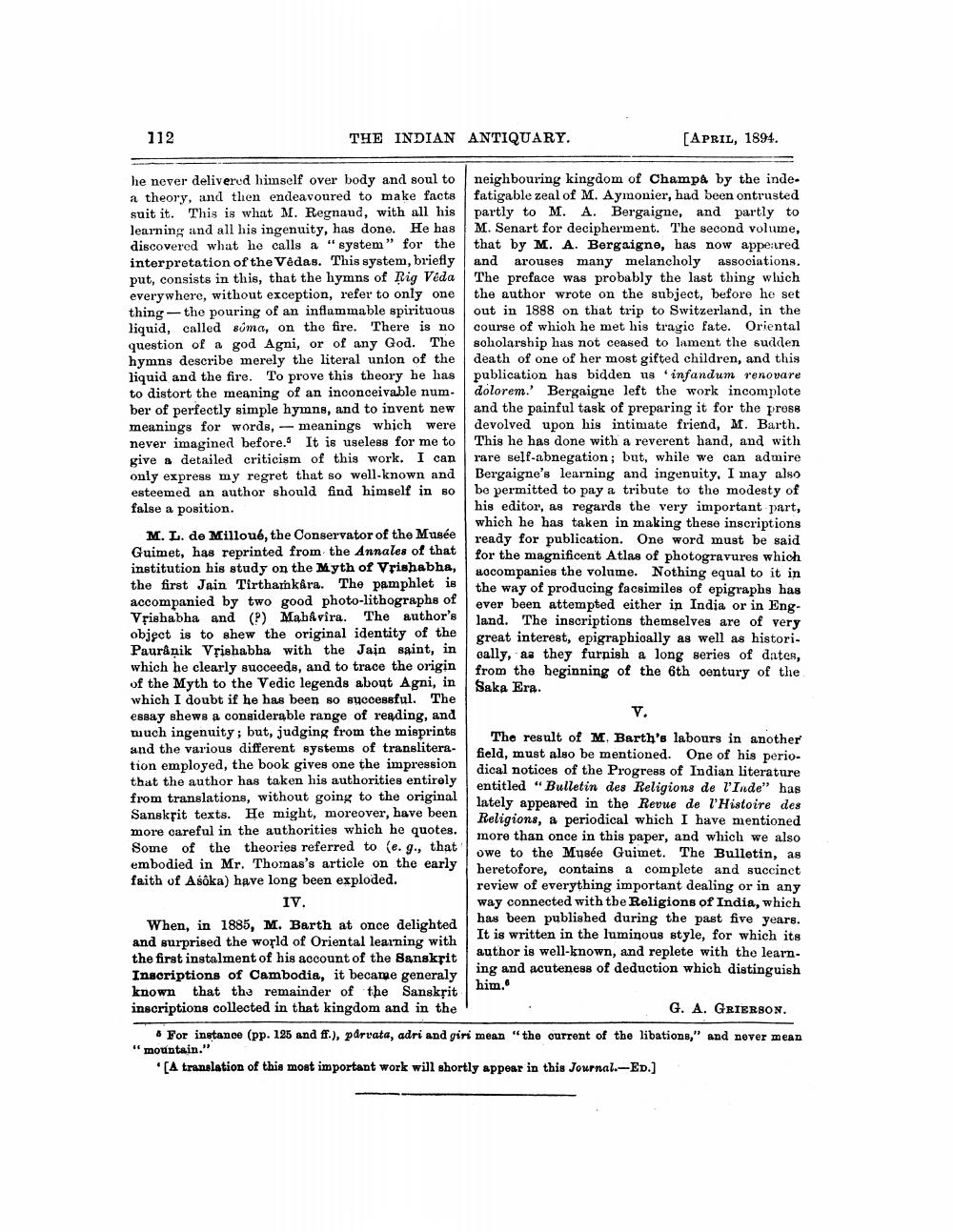________________
112
THE INDIAN ANTIQUARY.
[APRIL, 1894.
he never delivered himself over body and soul to neighbouring kingdom of Champa by the inde. a theory, and then endeavoured to make facts fatigable zeal of M. Aymonier, had been ontrusted suit it. This is what M. Regnaud, with all his partly to M. A. Bergaigne, and partly to learning and all his ingenuity, has done. He has M. Senart for decipherment. The second volume, discovered what he calls a "system" for the that by M. A. Bergaigne, has now appe:ured interpretation of the Vedas. This system, briefly and arouses many melancholy associations. put. consists in this, that the hymns of Rig Veda The preface was probably the last thing which everywhere, without exception, refer to only one the author wrote on the subject, before he set thing-the pouring of an inflammable spirituous out in 1888 on that trip to Switzerland, in the liquid, called sóma, on the fire. There is no course of which he met his tragic fate. Oriental question of a god Agni, or of any God. The soholarship has not ceased to lament the sudden hymns describe merely the literal union of the death of one of her most gifted children, and this liquid and the fire. To prove this theory he has publication has bidden us 'infandum renovare to distort the meaning of an inconceivable num- dolorem.' Bergaigne left the work incomplote ber of perfectly simple hymns, and to invent new and the painful task of preparing it for the prese meanings for words, - meanings which were devolved upon his intimate friend, M. Barth. never imagined before. It is useless for me to This he has done with a reverent hand, and with give a detailed criticism of this work. I can rare self-abnegation; but, while we can admire only express my regret that so well-known and Bergaigne's learning and ingenuity, I may also esteemed an author should find himself in so be permitted to pay a tribute to the modesty of false a position.
his editor, as regards the very important part,
which he has taken in making these inscriptions M. L. de Milloué, the Conservator of the Musée
ready for publication. One word must be said Guimet, has reprinted from the Annales of that
for the magnificent Atlas of photogravures which institution his study on the Myth of Vrishabha,
uocompanies the volume. Nothing equal to it in the first Jain Tirthamkåra. The pamphlet is
the way of producing facsimiles of epigraphe has accompanied by two good photo-lithographs of
ever been attempted either in India or in EngVfishabha and (P) Mab&vira. The author's
land. The inscriptions themselves are of very object is to shew the original identity of the
great interest, epigraphically as well as histori. Pauråạik Vrishabha with the Jain saint, in
cally, as they furnish a long series of dates, which he clearly succeeds, and to trace the origin
from the beginning of the 6th century of the of the Myth to the Vedic legends about Agni, in Saka Era. which I doubt if he has been so syccessful. The essay shews a considerable range of reading, and
v. much ingenuity; but, judging from the misprints
The result of M. Barth's labours in another and the various different systems of translitera
field, must also be mentioned. One of his periotion employed, the book gives one the impression
dical notices of the Progress of Indian literature that the author has taken his authorities entirely
entitled "Bulletin des Religions de l'Inde" has from translations, without going to the original
lately appeared in the Revue de l'Histoire des Sanskrit texts. He might, moreover, have been
Religions, a periodical which I have mentioned more careful in the authorities which he quotes.
more than once in this paper, and which we also Some of the theories referred to (e. g., that
owe to the Musée Guimet. The Bulletin, as embodied in Mr. Thomas's article on the early
heretofore, contains a complete and succinct faith of Asoka) have long been exploded.
review of everything important dealing or in any IV.
way connected with the Religions of India, which When, in 1885, M. Barth at once delighted
has been published during the past five years. and surprised the world of Oriental learning with
It is written in the luminous style, for which its the first instalment of his account of the Sanskrit
author is well-known, and replete with the learnInscriptions of Cambodia, it became generaly
ing and acuteness of deduction which distinguish known that the remainder of the Sanskrit
him. inscriptions collected in that kingdom and in the
G. A. GRIERSON. * For instance (pp. 125 and ff.), parvata, adri and giri mean "the current of the libations," and never mean "mountain."
*[A translation of this most important work will shortly appear in this Journal.-ED.)




